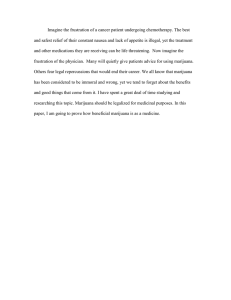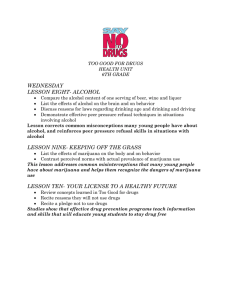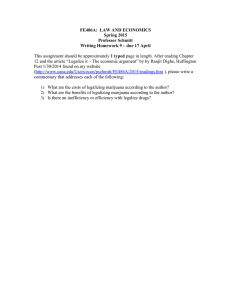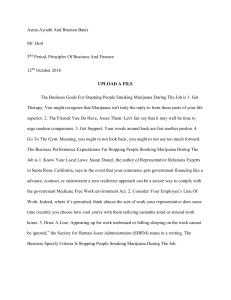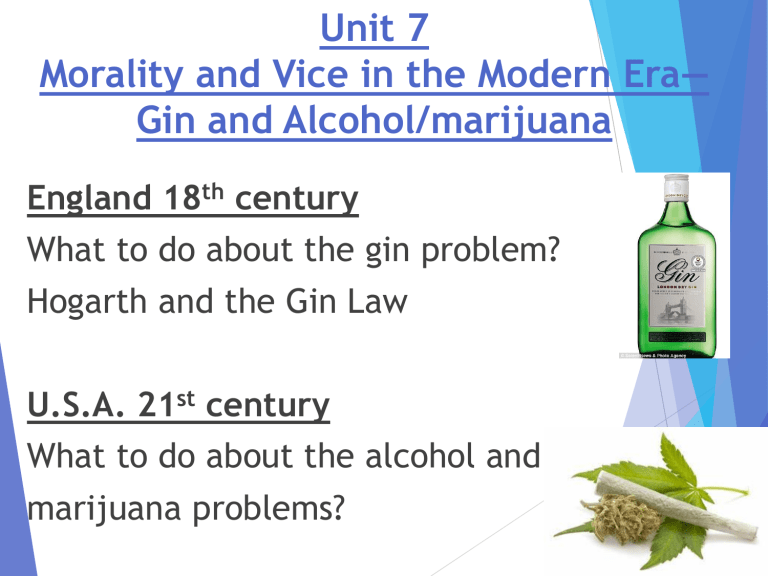
Unit 7 Morality and Vice in the Modern Era— Gin and Alcohol/marijuana England 18th century What to do about the gin problem? Hogarth and the Gin Law U.S.A. 21st century What to do about the alcohol and marijuana problems? Definitions How do we define: Morality? Vice (sin?)? Morality Morality is the belief that some behavior is right and acceptable and that other behavior is wrong. ...standards of morality and justice in society. Morality is a system of principles and values concerning people's behavior, which is generally accepted by a society or by a particular group of people. https://www.collinsdictionary.com/us/dictionary/english/ morality Vice Vice refers to criminal activities, especially those connected with pornography or prostitution. He said those responsible for offences connected with vice, gaming and drugs should be deported on conviction. A vice is a habit that is regarded as a weakness in someone's character, but not usually as a serious fault. His only vice is to get drunk on champagne after concluding a successful piece of business. https://www.collinsdictionary.com/us/dictionary/ english/vice_1 Relativity of Morality and Vice Clearly, what is considered moral behavior and what is considered a vice is relative to era, age, location, etc. I’m sure you can think of many things your parents might consider a vice, but you consider fine. Or that someone in one part of this country might consider perfectly moral behavior, but someone in a different part might consider immoral. Same with one country or culture versus another country or culture. Think about who determines what is moral and what is a vice? Does it have to do with who holds the power? Mainstream religion? Other things? Alcohol consumption—two case studies Drinking alcohol is an example of something that was considered a “vice” in both 18th c. British society and early 20th c. American society. Let’s take a look at these two examples and at the solutions proposed. England th 18 century “Gin Craze” in England There was a gin craze in England during first half of 18th century. WHY? Several factors… Hostile relations at end of 17th century between France and England led to a decrease in the import of French brandy. People started drinking gin instead. Government also passed laws that encouraged gin production, such as breaking the gin monopoly and therefore allowing more people/places to produce gin. Incomes were rising and food prices dropping, leaving people with extra money with which to buy gin. People had a sense of malaise due to increasing urbanization and alienation—self-medicated with gin. All these factors led to widespread addiction which spilled over into public drunkenness. “Gin Craze” in England By 1720s, politicians and social reformers began to pay attention to this public health problem and proposed some solutions. Legal: series of laws passed, concluding with the Gin Act of 1751. Economic: Gin Act set a minimum rent for gin sellers and severely restricted who could sell gin. Falling wages and higher food prices left people with less money to spend on gin. Social: Support systems were created to ease difficulties and sense of alienation of living in increasingly urban environment. William Hogarth Hogarth, an English painter and social critic, tried to help solve this problem. As a way to raise awareness and help the Gin Act get passed, he created several drawings and paintings of the negative effects of gin consumption. One of them, Gin Lane, shows extreme poverty and infant mortality, among other things. “Gin Lane” by Hogarth (1751) Can you find at least 12 examples that illustrate the negative effects of gin consumption? Required reading “William Hogarth’s Gin Lane has a lesson for binge drinking,” The Telegraph (12/30/12). http://www.telegraph.co.uk/health /healthadvice/maxpemberton/9769 425/William-Hogarths-Gin-Lane-hasa-lesson-for-binge-drinkingBritain.html The United States Alcohol Alcohol consumption has also been considered a serious “vice” in the U.S. during the past 100 years, especially in the early 1900s. Approaches to curbing it have varied, starting with an all out ban in 1920—Prohibition, and then government regulation. We see the same trajectory for marijuana, from a total ban to more government regulation, but not yet for the hardcore drugs. Alcohol in the U.S. Prohibition, 1920-1933 1920, the 18th amendment made it illegal to produce, import, transport, and sell alcohol. This was, in part, a result of puritanical Protestants reacting to wide-spread drinking in the 19th century. Also part of an antiimmigrant movement. Considered a failure for a variety of reasons (see Ken Burns video in next slide), in 1933 prohibition was ended with ratification of the the 21st amendment (which repealed the 18th amendment). Required video—Prohibition http://www.youtube.com/watch?v=jd40VnMG94 (13 mins) Optional questions: What reasons does Ken Burns give for failure of Prohibition? Do you think it was doomed to fail? Why? Why not? Is there a better way to control alcohol consumption? If so, what is it? Marijuana U.S. For many years marijuana was not considered a vice. It was grown by colonists to make hemp rope to send back to England, as required by King James I. Eventually, it was cultivated for use throughout the U.S. Marijuana—1800s By the 1850s, medicinal and recreational use of marijuana had become widespread. By 1853, every major city on the east coast had a “hashish” parlor. New York City had 500! In the beginning of the 20th c., attitudes about marijuana began to change. Marijuana users started being cast as murderers, rapists, and promiscuous women. As with alcohol, much of the antimarijuana sentiment was connected to anti-immigrant fervor. Legal restrictions—1900s In 1906, Congress passed the Pure Food and Drug Act, which required labeling of certain drugs. Marijuana was labeled as a poison in certain states. In 1930, the Federal Bureau of Narcotics was established and marijuana was regulated in all states. In 1937, the Marijuana Tax Act of 1937 was passed, which banned usage and sale of marijuana. An example of anti-marijuana propaganda From the 1930s to the 1950s, there was quite a bit of anti-marijuana propaganda. The film, Reefer Madness, is an example. It was shown in different states under different titles. [In the 1970s it became a cult classic and in 2005 it was remade into a satirical musical film.] Optional videos (but I encourage you to watch at least 10-15 minutes of each): Reefer Madness— the propaganda film and the musical Reefer Madness (1936)—the original https://www.youtube.com/watch?v=esfKfT BGadg Reefer Madness (2005)—the satirical musical (Hartt School performed it several years ago!) https://www.youtube.com/watch?v=VruJd M-CaeM Legal restrictions—1970s In the 1970s, the Controlled Substances Act set up “schedules” for drugs based on how addictive they were thought to be. Marijuana was put in the most restrictive category, Schedule I, although the Schafer Commission (under President Nixon), recommended that it should be removed from that category, suggesting it shouldn’t even be illegal. Nixon ignored the Commission’s recommendation, however, and marijuana stayed a Schedule I drug, which it still is today. This has had very serious implications for prison sentences for those caught with or selling marijuana (especially Black men, who have been disproportionately arrested and convicted). Attitudes toward marijuana begin to change—late 1980s and early 1990s Attitudes towards marijuana began to change again when people realized that marijuana helped AIDS patients feel more comfortable. People with other illnesses also began to benefit from marijuana. This led to legal changes in California. States move to legalize—1990s Medical usage In 1996, California became first state to legalize marijuana for medical usage. By now, 33 states and D.C. have legalized it, including Connecticut. Recreational usage In 2012, states began to pass laws to legalize marijuana for recreational usage. By now, 11 states, D.C., Guam, Puerto Rico and the U.S. Virgin Islands have legalized it for recreational usage. States: the Case of Connecticut Connecticut has legalized medical marijuana. Should it legalize recreational use as well? More than half of the states in the U.S. have done so and, as you can see from the map in the prior slide, in the New England region, Maine, Vermont and Massachusetts have as well. What are the pros and cons of legalizing recreational use in CT? Read the following four articles to learn more. Required readings (pdfs also on BB) “Opinion: Connecticut must reform marijuana laws to resolve disparities,” Newstimes (7/18/20) https://www.newstimes.com/opinion/article/OpinionConnecticut-must-reform-marijuana-laws-15417569.php “Don’t miss another opportunity to legalize marijuana,” Hartford Courant (9/3/20). https://www.courant.com/opinion/op-ed/hc-op-levitanmarijuana-legalization-0903-20200903tuvndcb4wfet7ap4m5jh2qf6l4-story.html “Should Connecticut legalize marijuana?” The Monroe Sun (3/8/20) https://themonroesun.com/should-connecticut-legalizemarijuana/ Federal Laws Marijuana remains illegal on the federal level, however. Doctors may not prescribe it under federal law, although they can “recommend” it under the 1st amendment (free speech). During the Obama administration, the federal government looked the other way and determined that prosecution was not a priority in states where it was legal. Trump Administration flip flopped for quite some time and most recently has supported the ban. Should the federal ban be lifted? The New York Times Editorial Board thought so in 2014 Why? Has been more than 40 years since current federal ban on marijuana. It is time. Ban has negative impact on health, society, and social order. It should be up to states to decide. At this point, it is up to “whim” of the president whether or not to enforce the ban. Marijuana is less dangerous than alcohol, which is already legal. A case for lifting the federal ban on marijuana Marijuana is not a “gateway” to more serious drugs. Social costs of marijuana ban: 2012: 658,000 arrests vs. 256,000 for heroin, cocaine, and related drugs. Black men are disproportionately arrested—ruins lives and creates new generation of “criminals.” A case for lifting the federal ban on marijuana Logistics of regulating: Can be overcome, despite complexities. Not a reason not to repeal the ban. Health issues: Scientists still debating health effects, but editorial board believes marijuana not as addictive as alcohol and tobacco. No apparent risk for healthy adults. However, should be restricted to those over 21, as could affect development of young brains. 2020 House of Representatives The US House Democrats were all set to introduce a bill this fall to decriminalize marijuana, meaning anyone caught with the drug would be subject to a fine, not a jail sentence. However, due to the objection of centrist democrats the effort has been postpone. Stay tuned! Required readings “Repeal Prohibition, Again,” NYT (7/27/14). PDF on Blackboard. https://www.nytimes.com/interactive/2014/0 7/27/opinion/sunday/high-time-marijuanalegalization.html “House will vote on federal marijuana legalization for the first time, bill's future in Senate uncertain,” USA (9/4/2020) PDF on Blackboard. https://www.usatoday.com/story/news/politic s/2020/09/04/marijuana-house-vote-federallegalization-first-time/5678068002/ Discussion Board Assignments DB post, due Tues, 1/5, midnight: Answer the question: “Should Connecticut legalize marijuana for recreational use?” Use information from the PPT (including readings and videos) for your resources—you don’t need to do any other research. DB response to a classmate’s post, due Wed, 1/6, midnight. Read at least five of your classmates’ posts. Find one that resonates with you in some way (could be similar to or completely different from your experience) and reply to that classmate. Be sure to explain why you chose that particular post.

